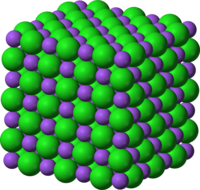
Photo from wikipedia
Disordered rock salt cathodes showing both anionic and cationic redox are being extensively studied for their very high energy storage capacity. Mn-based disordered rock salt compounds show much higher energy efficiency… Click to show full abstract
Disordered rock salt cathodes showing both anionic and cationic redox are being extensively studied for their very high energy storage capacity. Mn-based disordered rock salt compounds show much higher energy efficiency compared to the Ni-based materials as a result of the different voltage hysteresis, 0.5 and 2 V, respectively. To understand the origin of this difference, we herein report the design of two model compounds, Li1.3Ni0.27Ta0.43O2 and Li1.3Mn0.4Ta0.3O2, and study their charge compensation mechanism through the uptake and removal of Li via an arsenal of analytical techniques. We show that the different voltage hysteresis with Ni or Mn substitution is due to the different reduction potential for anionic redox. We rationalized such a finding by DFT calculations and propose this phenomenon to be nested in the smaller charge transfer band gap of the Ni-based compounds compared to that of the Mn ones. Altogether, these findings provide vital guidelines for designing high-capacity disordered rock salt cathode materials based on anionic redox activity for the next generation of Li ion batteries.
Journal Title: Journal of the American Chemical Society
Year Published: 2019
Link to full text (if available)
Share on Social Media: Sign Up to like & get
recommendations!